Like clothes moths, carpet moths hide in dark spaces such as those beneath furniture, allowing their population to reach devastating levels before you even notice a problem.
Carpet moth eggs are so small you won’t notice them, but their larvae are easily identified due to the case they carry around, which gives them their common name. If you spot a tiny grub wrapped in a woven case dragging itself around, you’ve got carpet moths.
When they’ve had their fill of your belongings, the larvae seal this case at both ends, creating a fuzzy parcel the size of a grain of rice in which they pupate into adult moths.
The adults are dull grey and tiny, with a wingspan of only 15-17mm. Most the time they won’t be flying though: females barely fly at all and males flutter just above the floor – another reason they can go unseen for so long.












